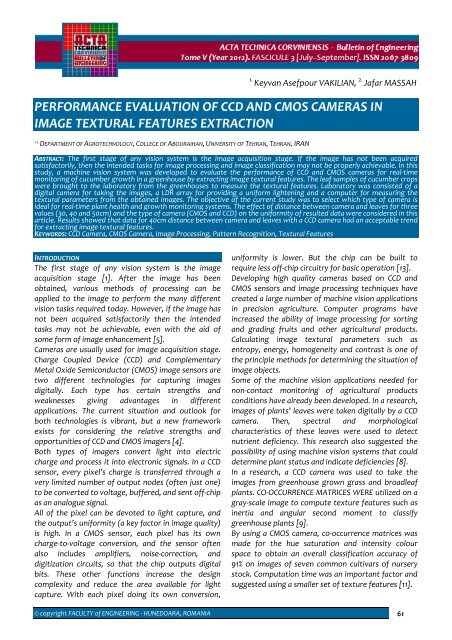1 - Acta Technica Corviniensis
1 - Acta Technica Corviniensis
1 - Acta Technica Corviniensis
Create successful ePaper yourself
Turn your PDF publications into a flip-book with our unique Google optimized e-Paper software.
1.Keyvan Asefpour VAKILIAN, 2. Jafar MASSAHPERFORMANCE EVALUATION OF CCD AND CMOS CAMERAS INIMAGE TEXTURAL FEATURES EXTRACTION1‐2.DEPARTMENT OF AGROTECHNOLOGY, COLLEGE OF ABOURAIHAN, UNIVERSITY OF TEHRAN, TEHRAN, IRANABSTRACT: The first stage of any vision system is the image acquisition stage. If the image has not been acquiredsatisfactorily, then the intended tasks for image processing and image classification may not be properly achievable. In thisstudy, a machine vision system was developed to evaluate the performance of CCD and CMOS cameras for real‐timemonitoring of cucumber growth in a greenhouse by extracting image textural features. The leaf samples of cucumber cropswere brought to the laboratory from the greenhouses to measure the textural features. Laboratory was consisted of adigital camera for taking the images, a LDR array for providing a uniform lightening and a computer for measuring thetextural parameters from the obtained images. The objective of the current study was to select which type of camera isideal for real‐time plant health and growth monitoring systems. The effect of distance between camera and leaves for threevalues (30, 40 and 50cm) and the type of camera (CMOS and CCD) on the uniformity of resulted data were considered in thisarticle. Results showed that data for 40cm distance between camera and leaves with a CCD camera had an acceptable trendfor extracting image textural features.KEYWORDS: CCD Camera, CMOS Camera, Image Processing, Pattern Recognition, Textural FeaturesINTRODUCTIONThe first stage of any vision system is the imageacquisition stage [1]. After the image has beenobtained, various methods of processing can beapplied to the image to perform the many differentvision tasks required today. However, if the image hasnot been acquired satisfactorily then the intendedtasks may not be achievable, even with the aid ofsome form of image enhancement [5].Cameras are usually used for image acquisition stage.Charge Coupled Device (CCD) and ComplementaryMetal Oxide Semiconductor (CMOS) image sensors aretwo different technologies for capturing imagesdigitally. Each type has certain strengths andweaknesses giving advantages in differentapplications. The current situation and outlook forboth technologies is vibrant, but a new frameworkexists for considering the relative strengths andopportunities of CCD and CMOS imagers [4].Both types of imagers convert light into electriccharge and process it into electronic signals. In a CCDsensor, every pixel’s charge is transferred through avery limited number of output nodes (often just one)to be converted to voltage, buffered, and sent off‐chipas an analogue signal.All of the pixel can be devoted to light capture, andthe output’s uniformity (a key factor in image quality)is high. In a CMOS sensor, each pixel has its owncharge‐to‐voltage conversion, and the sensor oftenalso includes amplifiers, noise‐correction, anddigitization circuits, so that the chip outputs digitalbits. These other functions increase the designcomplexity and reduce the area available for lightcapture. With each pixel doing its own conversion,uniformity is lower. But the chip can be built torequire less off‐chip circuitry for basic operation [13].Developing high quality cameras based on CCD andCMOS sensors and image processing techniques havecreated a large number of machine vision applicationsin precision agriculture. Computer programs haveincreased the ability of image processing for sortingand grading fruits and other agricultural products.Calculating image textural parameters such asentropy, energy, homogeneity and contrast is one ofthe principle methods for determining the situation ofimage objects.Some of the machine vision applications needed fornon‐contact monitoring of agricultural productsconditions have already been developed. In a research,images of plants’ leaves were taken digitally by a CCDcamera. Then, spectral and morphologicalcharacteristics of these leaves were used to detectnutrient deficiency. This research also suggested thepossibility of using machine vision systems that coulddetermine plant status and indicate deficiencies [8].In a research, a CCD camera was used to take theimages from greenhouse grown grass and broadleafplants. CO‐OCCURRENCE MATRICES WERE utilized on agray‐scale image to compute texture features such asinertia and angular second moment to classifygreenhouse plants [9].By using a CMOS camera, co‐occurrence matrices wasmade for the hue saturation and intensity colourspace to obtain an overall classification accuracy of91% on images of seven common cultivars of nurserystock. Computation time was an important factor andsuggested using a smaller set of texture features [11].© copyright FACULTY of ENGINEERING ‐ HUNEDOARA, ROMANIA 61
















